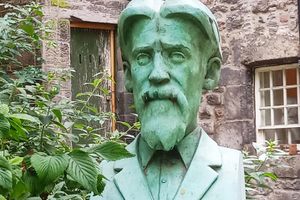About
For much of Edinburgh's long and fraught history, the city was surrounded by a protective stone wall. Access to and from the town center was limited to a number of gates. The most prosperous and ostentatious was the Netherbow, the entry that divided the Royal Mile from the separate municipality of the Canongate to the east.
People who wanted to enter or leave the walled city had to pay a hefty toll. For many of the poorer residents living behind this barrier, this was not a viable option, forcing them to remain forever within its confines. As a consequence, the term "The World's End" was given to this portion of the township.
As the Netherbow was a gatehouse, a bell was used to alert travelers that the gates were about to close or open. There would be a grace period allowing commuters to get out or stay behind before the gates were shut for the day.
The Netherbow Bell was part of an elaborate defense system that went as far back as far as the 14th century, though the bell itself probably didn't appear the 17th century. It was forged in the Netherlands in 1671. Adorned with a three-headed thistle emblem and a special inscription in both Latin and Scots by its creator, Dutch master bell-maker Michael Burgerhuis.
The etching reads: "The senate and the people of Edinburgh, from Holland 1621". There are also two mottos emblazoned on the surface of the bell; " To God be the Glory" and " Wha Daur Meddle Wit Me?, meaning: Who dare meddle with me?"
The bell would have had other uses, such as to alert people of danger or a fire, as a call to arms, or to signal the announcement of a public execution. One such hanging was James Mossman, official jeweler to James V and Mary, Queen of Scots loyalist. Who was hung, drawn and quartered for counterfeiting coins with the image of Mary on them. The bell is said to have even survived an invasion into the city by Oliver Cromwell's army.
The Netherbow gatehouse was demolished in 1764 to make the Royal Mile more accessible, and the bell was taken down and forgotten. Brass plaques among the cobblestones and a corner pub, aptly named The World's End, were all that remain to alert modern visitors to this bygone era. One such brick is etched with the date "1856", indicating the year when the separate neighboring burgh to the south, the Connangate, was incorporated into the city of Edinburgh
Up until the early 21st century, that is. For centuries, the lost Netherbow bell had been gathering dust in an orphanage's basement. It was eventually moved to a local art center, where it caught the eye of a keen observer. It was cleaned up and authenticated as the actual bell that rang out for centuries over the Netherbow Gatehouse. It now has pride of place atop the third floor of the Scottish Storytelling Centre.
In the early part of the 2000's, Edinburgh World Heritage, collected over £28,000 (nearly $35,000 USD) towards the of total sum of £2.5 million (over $3 million) for the restoration and re-hanging of the old city bell. This was a scheme for the preservation and the conservation for the Netherbow Arts Centre, now The John Knox House and Storytelling Centre.
Related Tags
Know Before You Go
The bell can be seen by standing outside The World's End pub, where the High Street meets Jeffery Street, and looking up toward the John Knox House. If you would like to see the bell up close, step inside the John Knox House and ask the staff politely. At their discretion, you may be led up the three flights of stairs to have a go at ringing it yourself.
Flavors of Scotland: Beyond the Haggis
Smoked seafood, single malt whisky, and warm hospitality.
Book NowPublished
October 7, 2019




















































